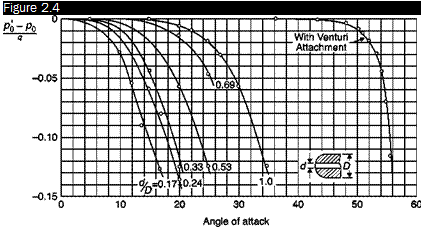The Pitot tube in yaw
If the Pitot tube is not aligned with the stream, the measured pressure is lower than the stagnation pressure since only the velocity component normal to the entrance section is stopped. The effect of the angle of incidence is negligible for angles less than, approximately, ±10° in the subsonic regime (Figure 2.4). This insensitivity is particularly beneficial in the Pitot tubes mounted on the nose of airplanes flying at non-zero angles of attack.
Figure 2.4 shows that the influence of the angle of attack also depends on the ratio of the hole diameter, d, and the outer diameter of the probe, D: in particular, the error for a given angle of incidence, decreases with the increase of the ratio d/D.
To increase the insensitivity to the alignment of the probe, a Kiel tube can be used (Figure 2.5), which is a Pitot tube immersed in a Venturi tube, which shows an insensitivity to angles of attack up to ±40° (Figure 2.6), or even ±60° with a modified version (on the right in Figure 2.5), obtained by changing the mouth of the Venturi: these features are achieved in the Kiel tube because the stream separation takes place only at very high angles of attack.
 |
Effects of the angle of incidence on the reading of a Pitot tube with different ratios between internal and external diameters
Best modification











